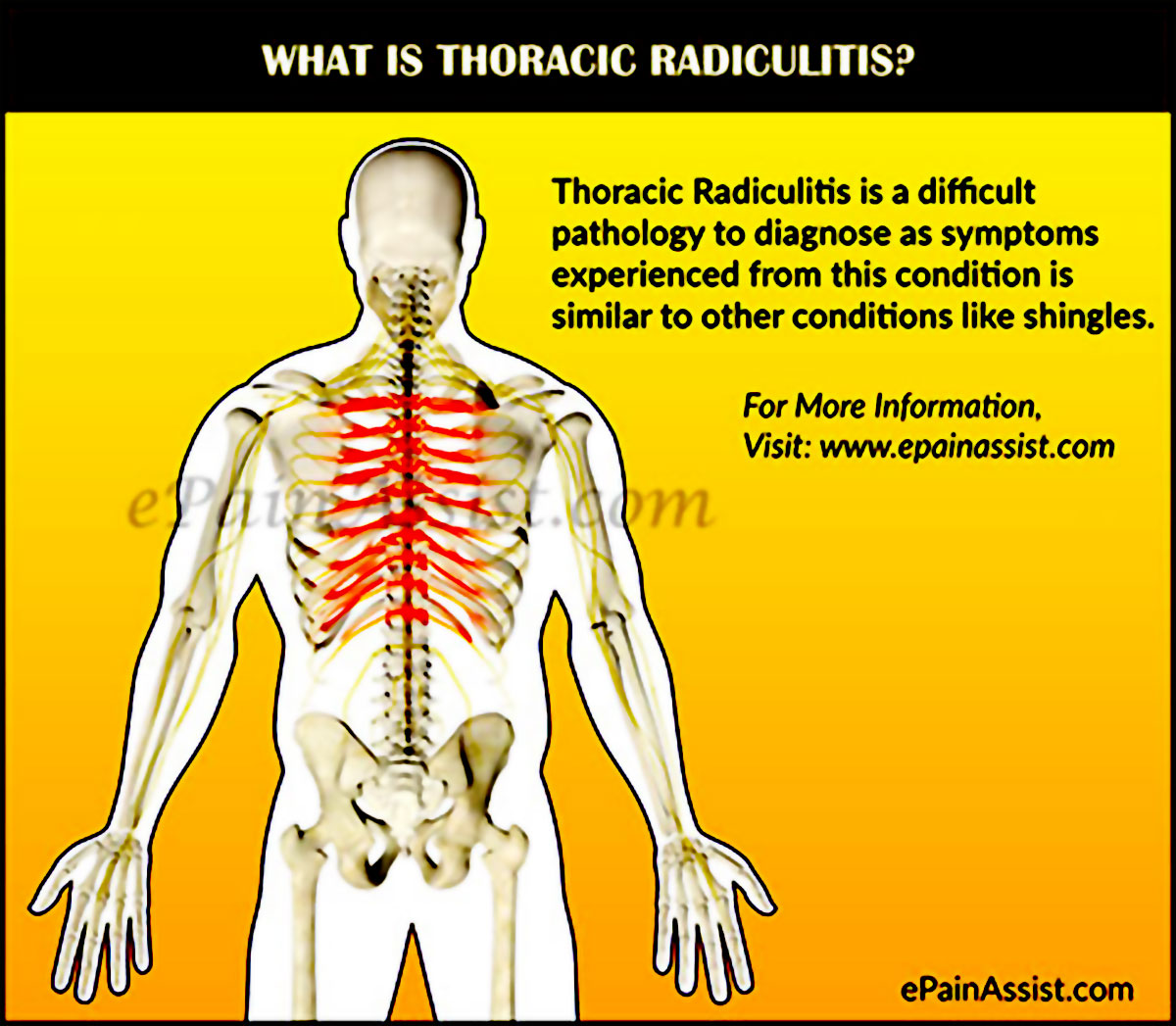What is Thoracic Radiculitis?
To understand what Thoracic Radiculitis is it is important to understand what exactly does radiculitis mean? Radiculitis is a term for a condition in which there is inflammation of the nerve roots in the spinal cord whose function is to transmit sensory and motor signals from the brain to the corresponding body part for effective working of the muscle, joint, or organ. These nerves exit the spinal cord through a minute hole which is formed by the surrounding bones and joints. When there is an inflammation of these bones and joints, there is less space for the nerves to pass through the exit normally resulting in the nerves to get impinged or compressed thus causing pain and other symptoms. Radiculitis can occur in lumbar, cervical or the thoracic spines but Thoracic Radiculitis is far less common than Cervical and Lumbar Radiculitis. Thoracic Radiculitis is a difficult pathology to diagnose as symptoms experienced from this condition is similar to other conditions like shingles. Thoracic Radiculitis can be diagnosed through radiological studies like x-rays, CT scan or MRI scans. Nerve conduction studies are also quite helpful in diagnosing Thoracic Radiculitis as they will give a clear picture of the functioning of the nerves and whether there is any compression of the nerve resulting in a slow conduction velocity.

What Can Cause Thoracic Radiculitis?
Some of the common causes of Thoracic Radiculitis are:
- Thoracic Radiculitis is often caused due to Disc herniation or disc bulge as a result of which the nerves get impinged or compressed.
- Thoracic Radiculitis Caused due to Costovertebral Restriction: This can also result in impingement of the nerve roots in the thoracic spine causing Thoracic Radiculitis.
- Thoracic Radiculitis Caused due to Soft Tissue Injuries: Soft tissue injuries affecting the thoracic spine can also result in bulging or herniation of the discs and as such may result in Thoracic Radiculitis.
- Spinal Stenosis is one of the most common causes of Thoracic Radiculitis
- Arthritis is also known to be one of the leading causes of Thoracic Radiculitis.
- In some cases tumors in the thoracic spine area can also result in compression of the nerves causing Thoracic Radiculitis.
What are the Symptoms of Thoracic Radiculitis?
Some of the symptoms of Thoracic Radiculitis are:
- Muscle tightness and spasms in the muscles of the neck and upper back
- Experience of severe pain in the shoulders, forearm, and hand which maybe coming from the thoracic spine region.
- Severe pain with a burning sensation down the arm or across the chest can be a symptom of Thoracic Radiculitis.
- Feeling of weakness of the muscles of the shoulders, arm, hand and back
- Electrical shock like sensation and the thoracic area being extremely hypersensitive to touch
- Experiencing numbness or tingling in the arm, chest, back and hand is also a symptom of Thoracic Radiculitis.
How is Thoracic Radiculitis Diagnosed?
In order to diagnose Thoracic Radiculitis, as stated the first thing to do is rule out conditions like shingles which may mimic the symptoms of Thoracic Radiculitis. Once it is done, the physician will then do a careful inspection of the upper back area where the pain seems to be coming from to look for area of tenderness and pain. Once a careful examination is done, then the physician will order radiological studies in the form of CT or MRI scan to look at the internal structures of the upper back or thoracic spine which will give a clear picture of whether there is any inflammation of the bones or joints and whether there is any compression of the nerves in the thoracic spine. Additionally, a nerve conduction velocity study may be recommended to check on the status of the functioning of the nerves and confirming the diagnosis of Thoracic Radiculitis.
How is Thoracic Radiculitis Treated?
The front line treatment for Thoracic Radiculitis is normally conservative approach. To begin with the physician will recommend starting with physical therapy with stretching and strengthening the spine to check whether there is any relief of the symptoms. The physician may also recommend chiropractic manipulation for resolution of symptoms of Thoracic Radiculitis. In cases where conservative therapy for Thoracic Radiculitis does not provide relief of symptoms then the physician may then recommend steroid injections in the spine. These injections give temporary symptom relief which may last for as long as a year but then the symptoms of Thoracic Radiculitis tend to come back and ultimately the patient has to undergo a surgery to decompress the nerves that are compressed and relieve the symptoms caused by Thoracic Radiculitis.
Also Read:
